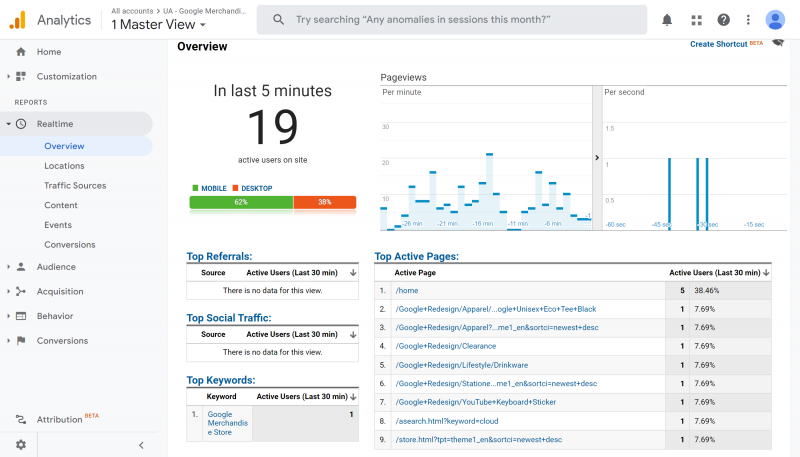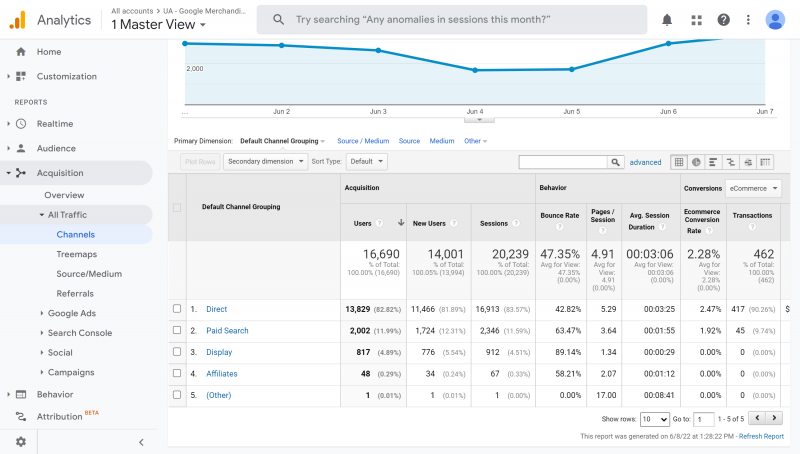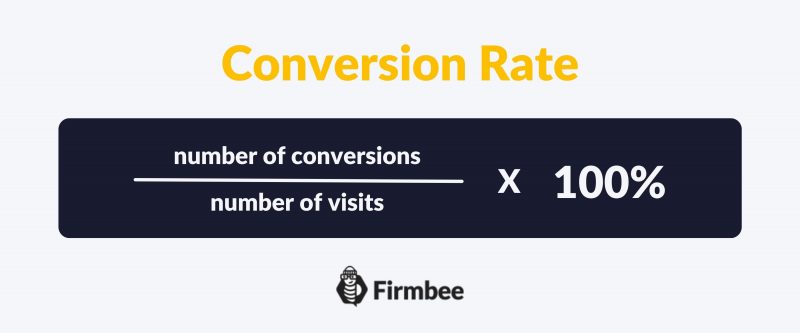Web conversion rate and website traffic are the most popular indicators used in digital marketing. Currently conversion rate optimization has become a central element of web analytics and a must for e-commerce industry. Both indicators have an impact on sales and revenue of online shops therefore individuals that sell via the Internet have to know how to calculate the conversion rate and measure web traffic. Read the article and find out more about those important parameters.
Website traffic and web conversion rate – table of contents:
- What is website traffic?
- What a conversion is?
- Conversion rate
- What percentage of conversion rate should you aim for?
- How to optimize the conversion?
- What are the main areas of optimization?
- Website traffic – summary
What is website traffic?
Website traffic refers to the number of all unique users of the internet that have visited the website at a given time. Analysis of this one indicator allows the owner of the online shop measure effectiveness of undertaken promotional actions as well as draw some conclusions related to those actions and in consequence work on better promotional strategies.
The most popular tool to measure website traffic is Google Analytics. The owner of the website may check the number of currently active website users by going to the Reports tab, where he has to choose Real-time, then Overview to display the information.

When the owner of the website wants to check the total number of pageviews within a certain time frame he has to choose the Behavior tab, then Site Content, and next All Pages to display this data.
During the analysis of the website traffic one can track back the source of traffic and check from which pages the visitors are coming to our website. This functionality is available in the Acquisition tab, where we click All traffic and then choose Channels option.

The main sources of the traffic on the website can be divided into several categories such as:
- Direct – as the name suggests, all the direct visits to the website made by the user, who entered the website name in his browser or used previously saved name in his browser tab, are in this group.
- Organic – describes organic traffic that is generated by the users that entered the website by clicking on the link in unpaid search results in the Google (or other browsers).
- Social – the source of this traffic refers to users that visited the page after using the link on the social networking site (Facebook, YouTube, etc.)
- Referral – the category describes the source of traffic that is generated by the users who enters the website via the link from the other websites (that are other than a social networking sites).
- Paid Search – here the source of traffic comes from the links that appear as paid search results.
- Display – the source of this traffic is based on clicks from display ads (display advertising can be in the form of standard, static banners or in animated form and they may include text, images or videos).
- Affiliates – this category describes the amount of visits that derive from clicks on links that are related to the affiliate programs.
The analysis of the website traffic allows the review of the information about all technical facts related to the visits on the website – we may find out such data as: who visits the website, what type of devices our visitors use, how many visitors decides to make a purchase after a visit on our page. Such statistics allow the owner of the website to understand the profile of his visitors and in consequence optimize the conversion accordingly to the needs of his target audience.
Check out: how to analyse your website traffic with Google Analytics.
What a conversion is?
A conversion refers to real actions of internet users, especially those actions that are predesigned, predicted, and desired by the website owners.
The whole business of content sharing is devised to draw the attention of the users and changing them into active participants of the process. Depending on the nature of the website the goals of the conversion may vary. Among the most popular aims of the conversion are:
- subscribing to the newsletter
- account registration
- making a purchase
- completing the form
- watching the video contained within a web page
The specific and clear illustration of the conversion goal is necessary to further measurement and monitoring of this indicator. Such analysis allows examining effectiveness of the tasks conducted.
Conversion rate
Conversion rate is a parameter that measures the effectiveness of your marketing activities. This indicator determines precisely the number of conversions on the website in comparison to the number of visits to the given website. The low conversion rate may suggest that the offer is not interesting enough for the internet users or that the website is not designed accordingly with the guidelines of UX. This may mean that there are some errors on the website – for example there is no section where the user could subscribe to the newsletter.
For the calculation of the conversion rate the following formula is used:

What percentage of conversion rate should you aim for?
The conversion rates achieved by the websites are subjected to many factors. Much depends on the industry the company is operating in, the localization of the market and the source of the purchase orders.
The most effective advertisement is such that is placed in the partnership websites, thematic blogs, and discussions: those activities generate conversion rate up to 5,5%. Sources of information that recommend products and provide technical and substantial content are well received by the customers.
Among the most effective ways to reach the customers are the newsletters and the databases with the details of the current business partners. The conversion rates achieved with the use of e-mail marketing are slightly lower – here the research indicates the conversion rate of range between 5% and 5,5 %.
Organic traffic, which is the most standard way to attract clients, is not the most efficient way to get high conversion rates. The mere presence in the unpaid search results that appear in the browser is not enough to draw attention to your product. Studies reveal that in this case the conversion rate fluctuates in the vicinity of 2% and this is not the particularly impressive figure. The owner of the website has to wait for the results for a long time, while the competition grows constantly.
The lowest conversion rates are related to the traffic generated by the social media and fluctuate in the vicinity of range between 0,7% and 1,7%. Undoubtedly, the best rates in this category belong to the Facebook that is the biggest and the most expensive social media to use.
How to optimize the conversion?
Conversion Rate Optimization (CRO) is an activity performed to improve the conversion rates. Typical optimization should take into account the previously set objectives and adjust the content to the client’s needs. The CRO strategy should be focused on the improvement of those elements of the website that have a real impact on conversion rates.
What are the main areas of optimization?
Appearance and functionality adjusted to the viewers
- User experience – the website that shows interesting design, that is intuitive, easy to use, and user friendly increases the conversion rates.
- Loading speed – the website that is loading slowly may discourage the user from further interaction with the page and in consequence force him to abandon the website.
- Minimalism and clear communication – light in color, clearly arranged, full of precise messages websites are more appreciated in recent times. The websites that include too many distractions – such as flashy banners, bright colors, huge amount of images – bring chaos to the page and the users may be deterred from using them.
- Adjustment to the target group – the content that is placed on the website should aim at a particular target group of users. It is worth to think about the selection of elements such as: look of the site, language, images, texts, and the offer.
Purchase process
- SSL protocol – such protocol is standard for data encryption that allows to make stable, secure connections between the servers and web users. The presence of SSL certificate on the website increases the trust of the users and provides better optimization of the website with the browsers.
- Cross-selling and up-selling – the first action is a cross-selling – here we offer products that are supplementary to the previously viewed by the client. Up-selling means offering the product that is of better quality and from a higher price shelf.
- Reviews – many internet users browse reviews before making a decision about a purchase. Reviews that are on the website have a positive impact on brand image and increase client’s trust.
- Simplified purchasing process – the client who decides to make a purchase should have a chance to go to the whole purchasing process really quickly. The website should not require from him any unnecessary information. It is worth to design the purchasing process status guide to inform the client about the stage of his buying activity.
Communication with the user and brand image
- Professional content – offering of valuable content builds the brand image of the company that aims to show its professionalism in the given industry, valuable content increases credibility of the company.
- Unique content – the content has to be unique, copying from other articles is not allowed.
- Properties – optimization of the properties is of great importance from the perspective of the SEO. It is worth to take care of headlines with keywords and metadata for websites. The optimization of the images is equally important – they should be described with the right attribute.
- Communication – each individual is different and has own preferences, hence the brand should allow their users to make choices related to the form of contact with the company. Among communication channels there should be: telephone, chat, and e-mail. The promptness of responses to the clients is equally important.
Google Analytics is one of the tools that can be used to measure the conversion. With this tool the website owner may get the full information about the effectiveness of his optimization activities. The tool shows: how many users visited the website, how long was their session and what kind of actions they had performed on the website. The analysis of conversion shows possible problems that users experience while visiting the website and in consequence demonstrate what else could be improved on the website.

Website traffic – summary
The operations described above are intended to help the website owner to increase the web conversion rate and the website traffic on his page. Those two indicators should be observed carefully because they help to get to know visitors of the website as well as allow full assessment of the page in terms of clients expectations.
If you like our content, join our busy bees community on Facebook, Twitter, LinkedIn, Instagram, YouTube, Pinterest.
Author: Martin Sparks
E-commerce enthusiasts which constantly digs around the internet in order to make sure he hasn’t missed any important information on the topic of starting and scaling profitable online stores.


















